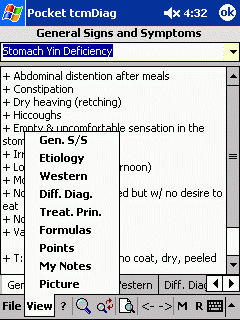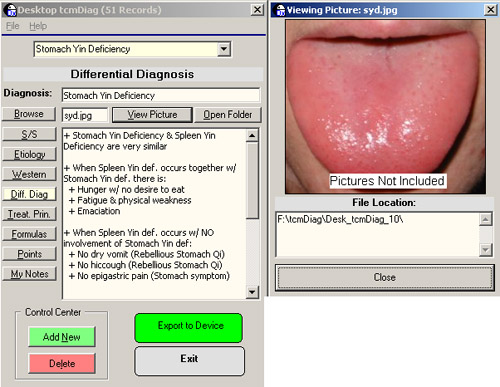tcmDiag
Introducing Pocket tcmDiag

Welcome to tcmDiag. This software will allow you to manage a database of over 50 common Traditional Chinese Medical Diagnosis / Zang-Fu Syndromes. There are over 19 8.5x11 pages of information packed into tcmDiag. You and Add, Delete, and Edit the the entire diagnosis database as you see fit. For each diagnosis there are 9 separate sections or pages to help guide you to the information you need. There is a "General Signs and Symptoms" section, "Etiology / Disease Cause" section, "Western Diagnosis" section which lists similar western diseases that roughly correspond to the TCM diagnosis, "Differential Diagnosis" section to help you separate a particular diagnosis from others, "Treatment Principles" section to help guide your priorities of treatment, "Formulas" section which contains some representative Chinese Herbal formulas to threat the given diagnosis, "Points" section which lists representative points for the disorder, "My Notes" section where you can add specific information such as clinic notes, book notes, etc., "Picture" section where you can scan-in or import digital camera pictures such as a tongue picture that matches the disorder, facial diagnosis, pulse wave patterns, etc. It's up to you. Once you have your database the way you want it, ONE click will export your database from the Included Desktop tcmDiag to a file ready to work with Pocket tcmDiag. You will then have a complete reference at your fingertips including many powerful searching and retrieval features such as: Single Search, Quick Search List, List All, Smart Searching and a powerful Multi-Search tool. |
Features:
- Gen. S/S page: This page includes a drop down box listing all
the Zang-Fu syndromes and also includes a comprehensive list of the
Zang-Fu syndrome Signs and Symptoms, and Tongue and Pulse presentations
- Etiology page: This page includes the various conditions, disorders
or situations that can cause each particular syndrome
- Western page: This page includes some common Western diagnosis
that roughly correlate with the given Zang-Fu syndromes
- Diff. Diag. page: This page will help aid you in differentiating
a given Zang-Fu syndrome with other syndromes that have similar presentations
- Treat. Prin. page: This page includes the common TCM treatment
principles needed to resolve the Zang-Fu syndrome
- Formulas page: This page includes the most common clinical
formulas used to treat the syndrome
- Points page: This page lists the most common and some not-so-common
/ special points used in treatments for each syndrome
- My Notes page: This page is blank and allows you to have additional
notes that will be associated with each syndrome
- Picture page: This
page will accommodate any .jpg picture you want associated with each
syndrome. Here you can include a representative
tongue picture, facial diagnosis, pulse wave pattern or perhaps a picture
of the ingredients of the most common treatment formula. It's
completely up to you how you use your picture page
- <- AND ->: These buttons allow you to navigate the various
pages like you would a web page with a web browser using the Back and
Forward buttons
- Results page: This page stores the results of your last search
in a nice, organized, sorted list. One click of a syndrome takes you
right to it! This list also allows you to compare and contrast different
syndromes based on your searching criteria without having to re-run
a search.
- Single Search: This allows you to search for ANY text in your database. So, finding all the syndromes
that, have "Dizziness" as a symptom, is a snap. tcmDiag will produce
a "Results" list of all the Syndromes that contain your search
term AND which page the search term was found on - then from there,
a single click brings you right to that page. Fast and easy or what?
- Quick Search List: This unique feature gives
you the ability to store your frequently typed search terms. Then with
two clicks, you can run the search again, all without re-typing which
saves you a tremendous amount of time especially when you are with a
patient
- List All: This button provides you with a
organized and sorted list of all the Syndromes in your database
- Smart Searching: There
is intelligence built into tcmDiag. For example, you are looking
at the Western page and notice "Anemia" is listed. You want to find all the syndromes that
have this western diagnosis, so what do you do? Easy, just use the stylus
to highlight "Anemia" and click the Search button. Instantly
you could have a list with several syndromes that share this diagnosis. Give
it a try!
 Advanced Multi-Search:
Advanced Multi-Search:
-
Multi-Search allows you to run one search using up to 3 different keywords. This is an "AND" search. What is meant by this is that Search Term 1 AND Search Term 2 AND Search Term 3 should appear together. This makes searching through your database very powerful. Now you can search for such keywords as "Pale Tongue" AND "Dizziness" and your results will display records that contain both terms.
- There are 2 options
you have as well.
- Terms must appear on the SAME Page: this means that out of the 8 pages (i.e. General s/s, Etiology, Western, etc.), your keywords must appear within the same page. Your results will be returned according to which page your terms were found on - then a single click will take you right to that page.
- Terms can be
on ANY Page: this means that the
entire record (Zang-Fu syndrome) is searched for your keywords
and then the results will be returned according to which
record
contains all of your keywords. Ex. you could search
for "Pale" and "Anemia". "Pale"
would most likely be on a General S/S page (i.e. pale tongue)
and "Anemia" would more than likely be on a Western
page - so your results would return records like "Heart
Blood Deficiency", "Heart Yin Deficiency", etc.
-
- TcmDiag also incorporates Zap Power-Off, so you can either exit tcmDiag or Turn Off your device, all from the Menu. Saving a lot of wear-and-tear on your Power Button.
Included Syndromes
(Remember, over 19, 8.5x11 pages
of information)
Heart Syndromes
Heart Yang Deficiency
Heart Yang Exhaustion
Heart Blood Stagnation
Heart Qi Deficiency
Heart Yin Deficiency
Heart Blood Deficiency
Hyperactivity of Heart Fire
Phlegm Misting the Heart (Cold type)
Phlegm Fire Disturbs the Heart
Small Intestine Syndromes
Small Intestine Qi Pain
Small Intestine Excess Heat
Small Intestine Deficiency Cold
Large Intestine Syndromes
Damp Heat in the Large Intestine
Consumption of Fluid in the Large Intestine
Deficiency Cold in the Large Intestine
Lung Syndromes
Invasion of Lung by Exogenous Wind Cold
Invasion of Lung by Exogenous Wind Heat
Invasion of Lung by Wind Dryness
Retention of Phlegm Heat in the Lung
Retention of Phlegm Damp in the Lung
Lung Qi Deficiency
Lung Yin Deficiency
Spleen Syndromes
Spleen Qi Deficiency
Spleen Qi Sinking
Spleen Not Controlling Blood
Spleen Deficiency Edema
Spleen Yang Deficiency
Invasion of Spleen by Cold Damp
Damp Heat in the Spleen and Stomach
Stomach Syndromes
Retention of Food in the Stomach
Stomach Cold
Stomach Fire Rising (Blazing)
Stomach Yin Deficiency
Liver Syndromes
Liver Qi Stagnation
Liver Qi and Blood Stagnation
Phlegm and Qi Stagnant and Blocked
Retention of Cold in the Liver Channel
Liver Fire Rising
Liver Yang Rising
Liver Blood Deficiency
Damp Heat in the Liver and Gallbladder
Liver Invades the Spleen
Liver Invades the Stomach
Liver Yang Rising turns into Wind
Extreme Heat Stirs Liver Wind
Deficiency of Blood Produces Liver Wind
Kidney Syndromes
Kidney Qi Deficiency
Kidney Yang Deficiency
Kidney Yin Deficiency
Kidney Jing Deficiency
Urinary Bladder Syndromes
Damp Heat in the Urinary Bladder
TcmDiag also comes with a Desktop version. This is a companion program that runs on Microsoft Windows 9x, NT, 2000, XP. This program allows you Add, Edit, Delete items in your database and then Export them to your Pocket PC (PPC). Here are just some of the features of the Desktop version:
- Built-in file transfer! With true 1-click ability, Desktop tcmDiag automatically transfers (exports) your database to your PPC
- Screen settings, database location, and other settings are remembered for the next time you start Desktop tcmDiag
- View your data exactly as it will be displayed on your PPC with the built-in "View in Pocket PC" mode. Makes for easy data layout & formatting before you export your database to your PPC
- Complete Help file
- Backup / Restore features so you can keep your database safe
- Desktop tcmDiag and the User Interface makes it very quick and easy to type any data right into the program by using shortcut-keys (Ex. Alt+S goes to the Signs / Symptoms page, Alt+N or Alt+D to add New or delete existing records, etc.)
- Built-in Auto-Save feature
- Built-in Picture viewer

Purchasing and Special Pricing Information

